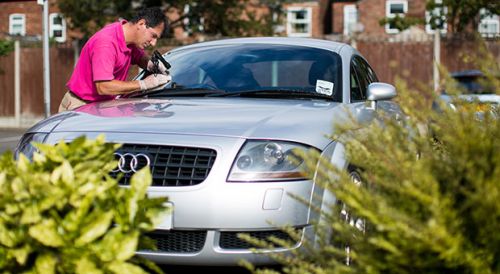
Wet leaves & antifreeze: Common car repair problems in autumn (and how to fix them)
Now that autumn is officially here, you’ll probably be looking for ways to maintain your car and prepare it for winter. Autumn comes with its own set of problems, though, so before you start planning what winter tyres you’re going to put on your car, make sure you know what common car repair problems you might encounter in autumn.
Wet leaves can cause all sorts of havoc on the roads but it’s also the time of year where you’ll need to make sure your fluids are topped up and ready for the colder weather too.
Paint damage
Just like bird mess, wet leaves can cause damage to your paintwork if left to sit. You can avoid this by parking away from trees but if your car does get covered with leaves, make sure to hose them off as soon as you can.
To protect your paintwork, make sure your car is waxed regularly as this creates a barrier over your paintwork, making it more difficult for the acids in wet leaves to seep through.
Leaves in your engine bay
With the sheer amount of leaves on the road, they’re bound to get into your engine bay. After a long or particularly leafy drive, check your engine bay and scoop out any leaves sitting on top or in gaps and crevices. You may need a leaf blower to remove some of the more stubborn ones.
Leaves can clog up the mechanical parts of your engine, get into your heating and air conditioning systems, and cause corrosion. If you take your car in for a service around this time of year, ask your mechanic to check the engine bay for stray leaves as they go.
Reduced stopping distances
Wet leaves on the road will reduce traction, just like snow or ice. If the road you’re driving on is covered in leaves, take care as stopping distances will be reduced. This will help you to avoid costly knocks and bangs, as well as more serious incidents.
Wheel damage
Leaves on the road can also hide potholes and other debris so take extra care as hitting a pothole at full speed can damage your wheels and put them out of alignment.
Stone chips
With debris being washed onto the roads, the likelihood of a stone chip on your windscreen is very high. Where safe, avoid driving close to the edge of the road and go slowly when the tarmac is obscured by leaves, mud and gravel. To stop these chips turning into costly cracks, find your nearest Optic-Kleer technician who can repair the chip - usually for free, depending on your insurer.
Frozen fluids
With freezing mornings, you might find your car struggling with frozen fluids. The key here is to add the right kind of anti-freeze to your radiator and windscreen washer reservoir. If you’re unsure what you need, ask for this to be done by a local garage.
Battery problems
Cold weather depletes a battery’s power so you might find yourself with a dead battery on chilly mornings. Most cars can be brought back to life with a jump start so if you find this happening regularly, make sure you carry jump cables with you and understand how to use them.
If your battery is old, you could need a replacement. If you’re getting frustrated, take your car to your local garage to get it checked out.
Dead bulbs
Some people don’t drive at night during the summer months so when the clocks change, many don’t realise a bulb has gone at some point in the last six months.
Give your car a good check all around including fog lights, indicators and brake lights as well as headlamps. If one is out, it’s usually a relatively cheap and easy fix for you to tackle yourself or for your local garage.
The key to maintaining your car in autumn and winter is to drive carefully and give your car the proper care and attention it deserves, even if that means washing it regularly or giving the battery a charge in between short journeys.

 Windscreen Chip Repair While You Shop - Optic-Kleer®
Windscreen Chip Repair While You Shop - Optic-Kleer®